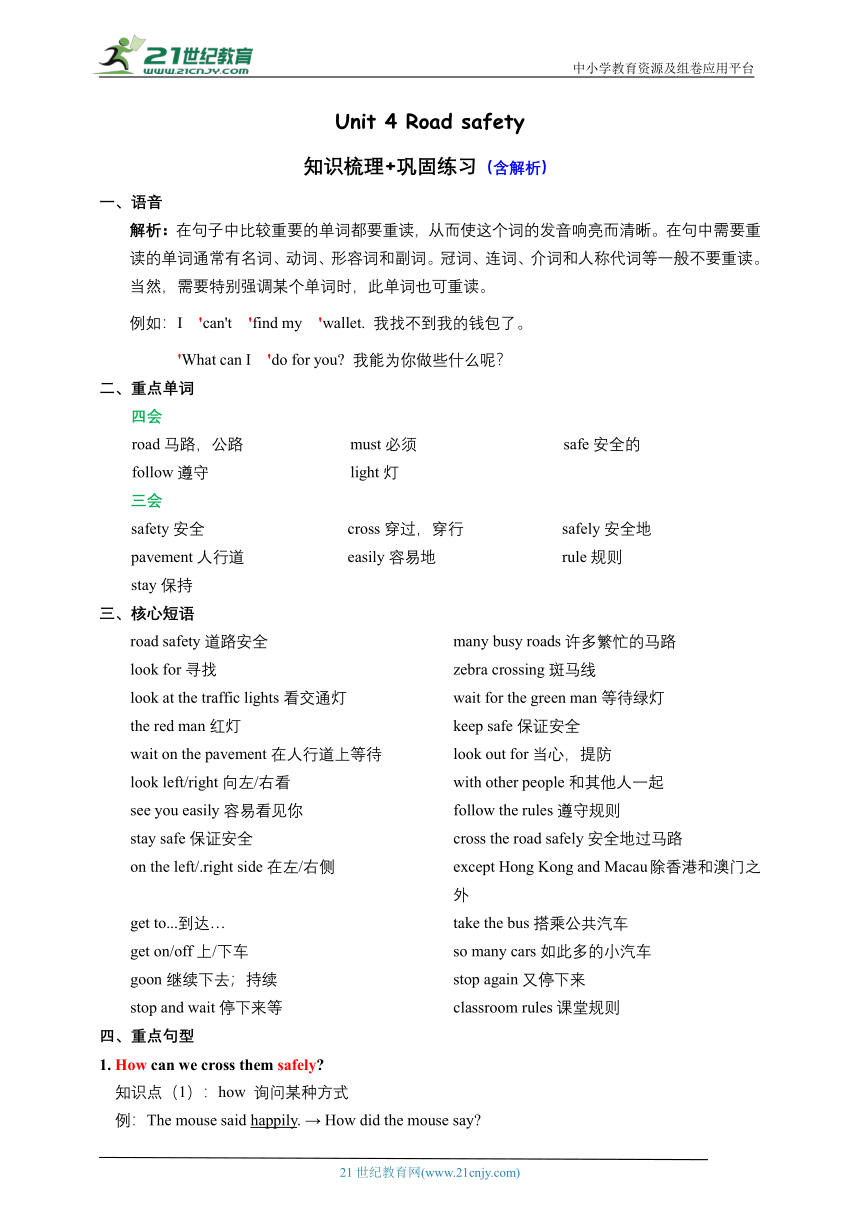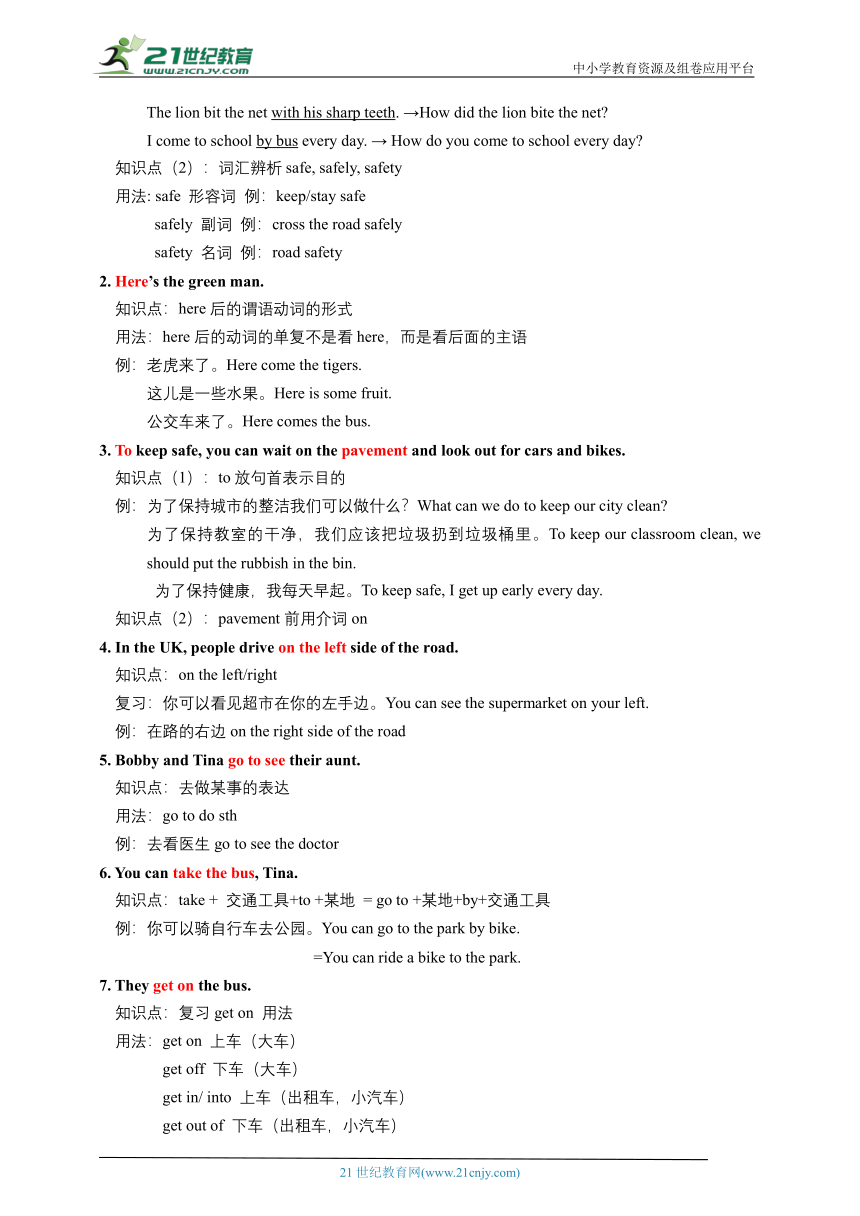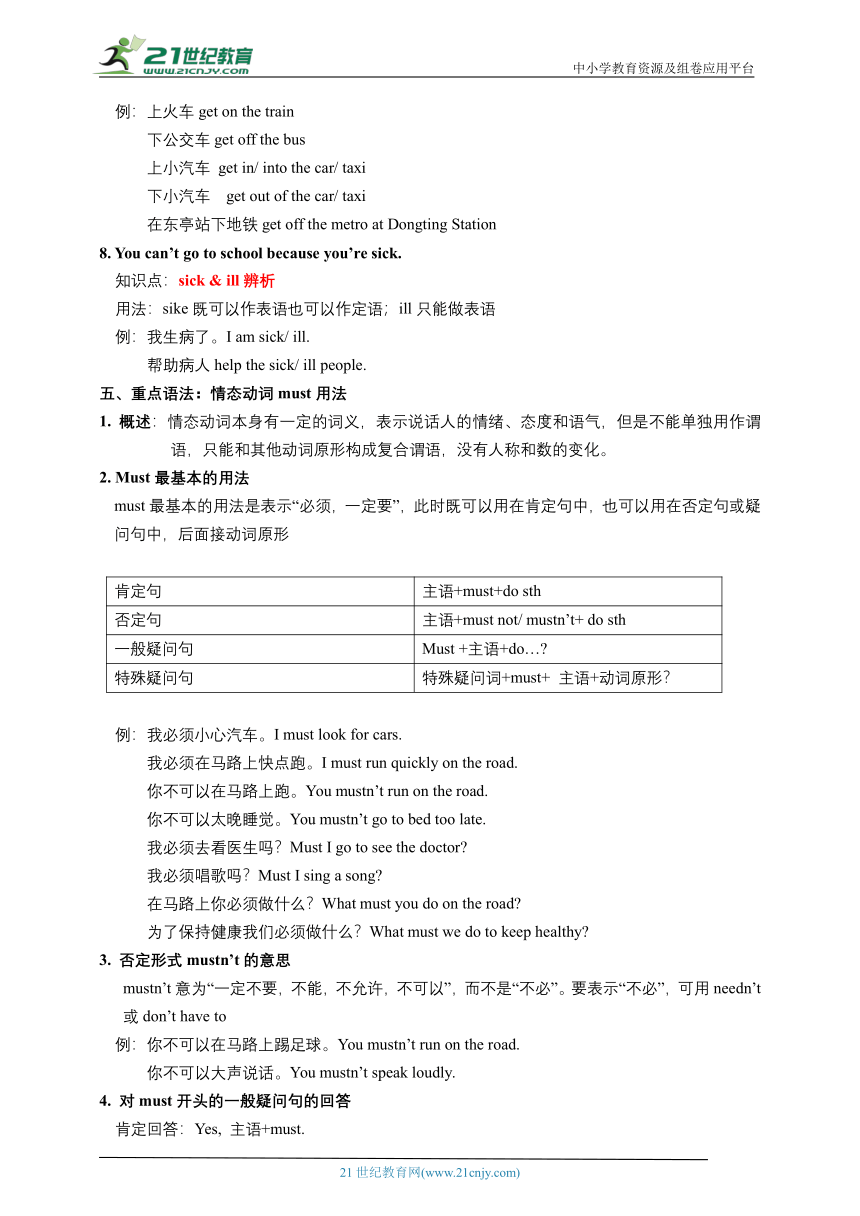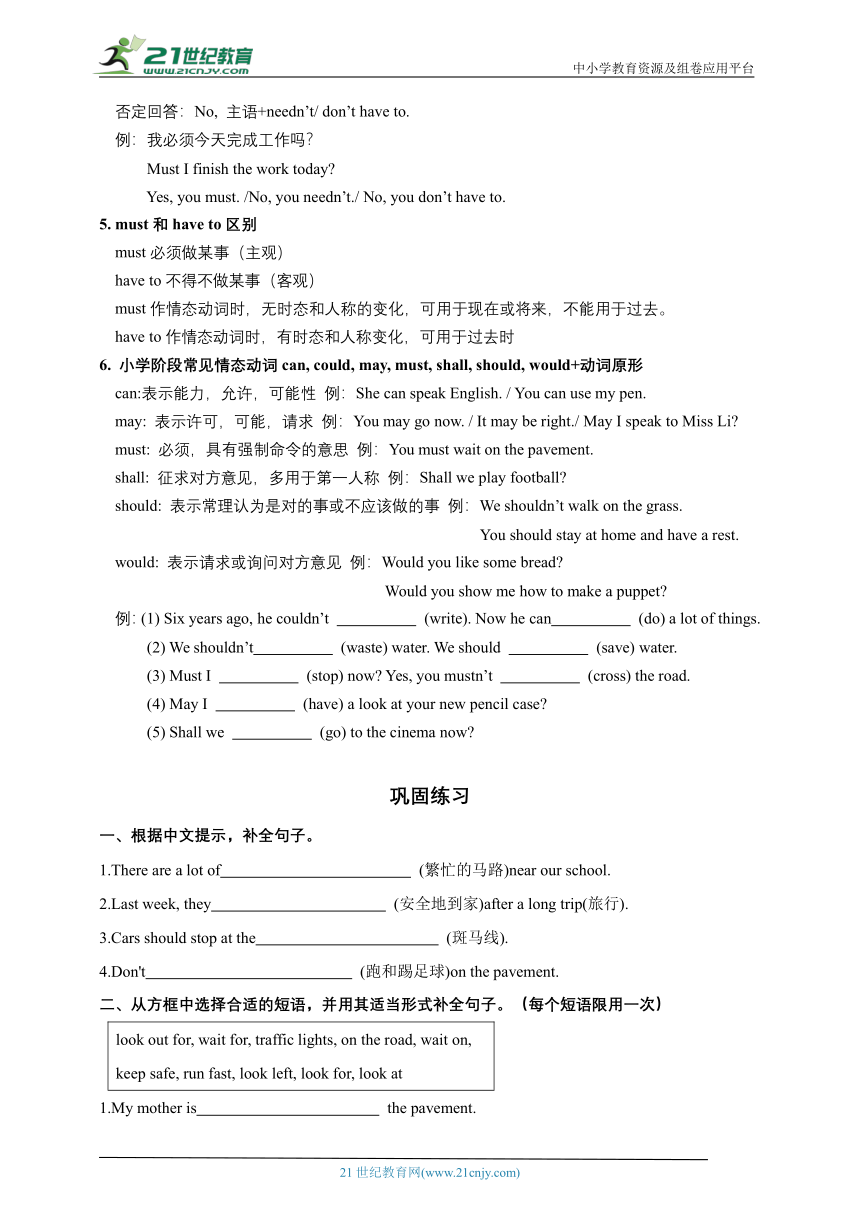【期末总复习】Unit 4 Road safety知识梳理+巩固练习(含答案)
文档属性
| 名称 | 【期末总复习】Unit 4 Road safety知识梳理+巩固练习(含答案) |  | |
| 格式 | doc | ||
| 文件大小 | 1.2MB | ||
| 资源类型 | 试卷 | ||
| 版本资源 | 牛津译林版 | ||
| 科目 | 英语 | ||
| 更新时间 | 2023-06-03 15:20:52 | ||
图片预览




文档简介
中小学教育资源及组卷应用平台
Unit 4 Road safety
知识梳理+巩固练习(含解析)
语音
解析:在句子中比较重要的单词都要重读,从而使这个词的发音响亮而清晰。在句中需要重读的单词通常有名词、动词、形容词和副词。冠词、连词、介词和人称代词等一般不要重读。当然,需要特别强调某个单词时,此单词也可重读。
例如:I 'can't 'find my 'wallet. 我找不到我的钱包了。
'What can I 'do for you 我能为你做些什么呢?
重点单词
四会
road马路,公路 must必须 safe安全的
follow遵守 light灯
三会
safety安全 cross穿过,穿行 safely安全地
pavement人行道 easily容易地 rule规则
stay保持
核心短语
road safety道路安全 many busy roads许多繁忙的马路
look for寻找 zebra crossing斑马线
look at the traffic lights看交通灯 wait for the green man等待绿灯
the red man红灯 keep safe保证安全
wait on the pavement在人行道上等待 look out for当心,提防
look left/right向左/右看 with other people和其他人一起
see you easily容易看见你 follow the rules遵守规则
stay safe保证安全 cross the road safely安全地过马路
on the left/.right side在左/右侧 except Hong Kong and Macau除香港和澳门之外
get to...到达… take the bus搭乘公共汽车
get on/off上/下车 so many cars如此多的小汽车
goon继续下去;持续 stop again又停下来
stop and wait停下来等 classroom rules课堂规则
重点句型
1. How can we cross them safely
知识点(1):how 询问某种方式
例:The mouse said happily. → How did the mouse say
The lion bit the net with his sharp teeth. →How did the lion bite the net
I come to school by bus every day. → How do you come to school every day
知识点(2):词汇辨析safe, safely, safety
用法: safe 形容词 例:keep/stay safe
safely 副词 例:cross the road safely
safety 名词 例:road safety
2. Here’s the green man.
知识点:here后的谓语动词的形式
用法:here后的动词的单复不是看here,而是看后面的主语
例:老虎来了。Here come the tigers.
这儿是一些水果。Here is some fruit.
公交车来了。Here comes the bus.
3. To keep safe, you can wait on the pavement and look out for cars and bikes.
知识点(1):to放句首表示目的
例:为了保持城市的整洁我们可以做什么?What can we do to keep our city clean
为了保持教室的干净,我们应该把垃圾扔到垃圾桶里。To keep our classroom clean, we should put the rubbish in the bin.
为了保持健康,我每天早起。To keep safe, I get up early every day.
知识点(2):pavement前用介词on
4. In the UK, people drive on the left side of the road.
知识点:on the left/right
复习:你可以看见超市在你的左手边。You can see the supermarket on your left.
例:在路的右边on the right side of the road
5. Bobby and Tina go to see their aunt.
知识点:去做某事的表达
用法:go to do sth
例:去看医生go to see the doctor
6. You can take the bus, Tina.
知识点:take + 交通工具+to +某地 = go to +某地+by+交通工具
例:你可以骑自行车去公园。You can go to the park by bike.
=You can ride a bike to the park.
7. They get on the bus.
知识点:复习get on 用法
用法:get on 上车(大车)
get off 下车(大车)
get in/ into 上车(出租车,小汽车)
get out of 下车(出租车,小汽车)
例:上火车get on the train
下公交车get off the bus
上小汽车 get in/ into the car/ taxi
下小汽车 get out of the car/ taxi
在东亭站下地铁get off the metro at Dongting Station
8. You can’t go to school because you’re sick.
知识点:sick & ill辨析
用法:sike既可以作表语也可以作定语;ill只能做表语
例:我生病了。I am sick/ ill.
帮助病人help the sick/ ill people.
重点语法:情态动词must用法
1. 概述:情态动词本身有一定的词义,表示说话人的情绪、态度和语气,但是不能单独用作谓语,只能和其他动词原形构成复合谓语,没有人称和数的变化。
2. Must最基本的用法
must最基本的用法是表示“必须,一定要”,此时既可以用在肯定句中,也可以用在否定句或疑问句中,后面接动词原形
肯定句 主语+must+do sth
否定句 主语+must not/ mustn’t+ do sth
一般疑问句 Must +主语+do…
特殊疑问句 特殊疑问词+must+ 主语+动词原形?
例:我必须小心汽车。I must look for cars.
我必须在马路上快点跑。I must run quickly on the road.
你不可以在马路上跑。You mustn’t run on the road.
你不可以太晚睡觉。You mustn’t go to bed too late.
我必须去看医生吗?Must I go to see the doctor
我必须唱歌吗?Must I sing a song
在马路上你必须做什么?What must you do on the road
为了保持健康我们必须做什么?What must we do to keep healthy
3. 否定形式mustn’t的意思
mustn’t意为“一定不要,不能,不允许,不可以”,而不是“不必”。要表示“不必”,可用needn’t或don’t have to
例:你不可以在马路上踢足球。You mustn’t run on the road.
你不可以大声说话。You mustn’t speak loudly.
4. 对must开头的一般疑问句的回答
肯定回答:Yes, 主语+must.
否定回答:No, 主语+needn’t/ don’t have to.
例:我必须今天完成工作吗?
Must I finish the work today
Yes, you must. /No, you needn’t./ No, you don’t have to.
5. must和have to区别
must必须做某事(主观)
have to不得不做某事(客观)
must作情态动词时,无时态和人称的变化,可用于现在或将来,不能用于过去。
have to作情态动词时,有时态和人称变化,可用于过去时
6. 小学阶段常见情态动词can, could, may, must, shall, should, would+动词原形
can:表示能力,允许,可能性 例:She can speak English. / You can use my pen.
may: 表示许可,可能,请求 例:You may go now. / It may be right./ May I speak to Miss Li
must: 必须,具有强制命令的意思 例:You must wait on the pavement.
shall: 征求对方意见,多用于第一人称 例:Shall we play football
should: 表示常理认为是对的事或不应该做的事 例:We shouldn’t walk on the grass.
You should stay at home and have a rest.
would: 表示请求或询问对方意见 例:Would you like some bread
Would you show me how to make a puppet
例:(1) Six years ago, he couldn’t (write). Now he can (do) a lot of things.
(2) We shouldn’t (waste) water. We should (save) water.
(3) Must I (stop) now Yes, you mustn’t (cross) the road.
(4) May I (have) a look at your new pencil case
(5) Shall we (go) to the cinema now
巩固练习
根据中文提示,补全句子。
1.There are a lot of (繁忙的马路)near our school.
2.Last week, they (安全地到家)after a long trip(旅行).
3.Cars should stop at the (斑马线).
4.Don't (跑和踢足球)on the pavement.
从方框中选择合适的短语,并用其适当形式补全句子。(每个短语限用一次)
look out for, wait for, traffic lights, on the road, wait on, keep safe, run fast, look left, look for, look at
1.My mother is the pavement.
2.Su Hai is some food to eat.
3.I my friend in the park every afternoon.
4.There are many on the road.
5.Don't run quickly .
6.When we cross the road, we must cars and bikes. We must first.
7.To , we must wait for the green man and then go.
8. the traffic lights. You must stop now.
9.Sam is on the playground.
单项选择。
( )1.To live a life, we should know follow the traffic rules.
A.safety;how to B.safe;what to C.safely;why to D.safe;how to
( )2.-- I watch TV
--No. You go to bed now.
A.Can;can B.Must;can C.Can;must D.Must;must
( )3.The students are reading writing in the library. We mustn't shout run there.
A.and;and B.and;or C.or;and D.or;with
( )4.This question is for me. I can work it out .
A.easily;easily B.easy;easy C.easy;easily D.easily;easy
根据首字母和上下文填空,补全短文。
In order to keep the road orderly(有秩序的) and people1.s , everyone should 2.f the traffic rules. The walkers should look 3.c both left and right when they are crossing the road. When people are driving, they should wear a seat belt(安全带). 4.D are not allowed to drive after drinking. They must stop when the 5.l is red. Many people take buses. They should wait in line, and follow the rule “First get 6.o , and then get 7.o .”
If everyone follows the traffic rules,there will be fewer traffic accidents.
根据提示完成填空,每空一词。
1.There (be) any traffic lights here.
2.To keep s , we must f the rules.
3.We m cross the road when the traffic lights are red.
4.To help drivers see you e , you'd better the road with other people.
单项选择。
( )1.Lily walks very , while her grandma walks very .
A.fast;slowly B.slow;fast C.fastly;slowly D.fast;slow
( )2.Look! He was waiting the pavement his parents.
A.on;on B.for;for C.on;for D.for;on
( )3.The children shouted , “There !”
A.excitedly;comes he B.excitedly;comes the girl
C.excited;he comes D.excited;the girl comes
( )4.When you walk the road, you need to look out the cars and bikes.
A.cross;at B.cross;for C.across;at D.across;for
( )5.When you there, please call me.
A.get B.reach C.arrive at D.get to
根据中文提示完成对话。
1.--我们怎样到达你家?
--你们可以乘出租车。
-- we your home
--You can the .
2.--我应该做什么? --你应该观察左右。
-- I do
--You should and .
3.--为什么那个男人在这里停了下来?
--看红灯。它的意思是我们必须停下。
-- the man here
--Look at the red . It we .
将下列句子重新排序,组成一段通顺的对话。
( 8 )All right. Hurry up, or we'll be late.
( )Good idea! But how do we go there
( )There is a new film in City Cinema. Let's go and see it.
( )The bus is coming. Oh! It's so full that we can't get on.
( )Let's go by taxi then. It's fast.
( )Let's go there by metro. Here is the station.
( )But look! There are so many cars in the street. They are moving slowly.
( 3 )By Bus No.2.
参考答案及解析
1.busy roads 2.got(arrived)home safely 3.zebra crossing
4.run or play football
1.waiting on 2.looking for 3.wait for 4.traffic lights
5.on the road 6.look out for; look left 7.keep safe 8.Look at 9.running fast
1.D解析:根据选项可知句意:为了安全的生活,我们应该知道如何遵守交通规则。safety安全;safe
安全的;safely安全地;how如何;what什么;why为什么。第一空用来修饰life,所以应该是形容词,因而应该为safe;第二空表示如何,所以应该用how。故选D。
2.C解析:考查情态动词。can可以,能够;must必须。根据选项可知句意:一我可以看电视吗 不可以,你现在必须睡觉。故选C。
3.B解析:and和,表示并列或递进,作为连词来连接两个并列成分;or或者,可以表示选择,也可以在否定句中表示并列。本题第一空为肯定句,用and;第二空为否定句,用or来表并列。故选B.
4.C解析:第一空是在be动词后面,应该用形容词;第二空是在动词短语work out后面,应该用副词来修饰。句意:这个问题对我来说是简单的。我可以很轻易地做出来。故选C。
1.safe解析:and连接相同词性的词,and前的orderly为形容词,根据句意及首字母可知应填形容
词safe“安全的”。
2.follow解析:根据句意及首字母可知填follow“遵守”。
3.carefully解析:结合上下文可推测句意:行人过马路时应仔细地看左右。此空修饰动词look,根据句意及首字母可知填副词carefully。
4.Drivers解析:句意:不得酒后驾车。根据句意及首字母可知考查单词driver“司机”,根据are可知driver用复数drivers,故答案为Drivers。
5.light 6.off
7.on解析:根据常识可知,乘车时应先下后上。故应“First get off,and then get on."。
1.aren't 2.safe;follow 3.mustn't 4.easily;cross
1.A解析:fast快,既可作为形容词也可作为副词;fastly无此词;slow慢的,形容词;slowly慢地,副
词。因为两个空都是修饰动词walk,故选用副词;再根据句意“Lily走得很快,她的奶奶走得很慢”可知选A。
2.C解析:pavement人行道。在人行道上用介词on.表示“等待某人”为固定短语wait for sb,故选C。
3.B解析:第一空用副词来修饰动词shout,excited兴奋的;excitedly兴奋地,排除C、D两项;第二空考查倒装句,如果主语是代词,只需要部分倒装即there he comes,主语是名词时,需要完全倒装,成为状一谓一主格式。故选B。
4.D解析:cross穿过,动词;across穿过,介词,因为横线前面是动词walk,所以不能选择cross,排除A、B两项;第二空考查固定搭配look out for,根据句意“当你过马路的时候,你需要当心汽车和自行车”可知选D。
5.A解析:考查动词短语。句意:当你到那里的时候,请给我打电话。get到达,是不及物动词,后面跟介词to搭配,后接here,there等副词时,可省略to;get to和arrive at后都要接地点;reach是及物动词,后面必须带宾语。题干后边没有地点,只有there,是副词,所以选A。
1.How can; get to; take; taxi 2.What should;look left;right
3.Why did/does; stop; man/light; means;must stop
82145763
HYPERLINK "http://21世纪教育网(www.21cnjy.com)
" 21世纪教育网(www.21cnjy.com)
Unit 4 Road safety
知识梳理+巩固练习(含解析)
语音
解析:在句子中比较重要的单词都要重读,从而使这个词的发音响亮而清晰。在句中需要重读的单词通常有名词、动词、形容词和副词。冠词、连词、介词和人称代词等一般不要重读。当然,需要特别强调某个单词时,此单词也可重读。
例如:I 'can't 'find my 'wallet. 我找不到我的钱包了。
'What can I 'do for you 我能为你做些什么呢?
重点单词
四会
road马路,公路 must必须 safe安全的
follow遵守 light灯
三会
safety安全 cross穿过,穿行 safely安全地
pavement人行道 easily容易地 rule规则
stay保持
核心短语
road safety道路安全 many busy roads许多繁忙的马路
look for寻找 zebra crossing斑马线
look at the traffic lights看交通灯 wait for the green man等待绿灯
the red man红灯 keep safe保证安全
wait on the pavement在人行道上等待 look out for当心,提防
look left/right向左/右看 with other people和其他人一起
see you easily容易看见你 follow the rules遵守规则
stay safe保证安全 cross the road safely安全地过马路
on the left/.right side在左/右侧 except Hong Kong and Macau除香港和澳门之外
get to...到达… take the bus搭乘公共汽车
get on/off上/下车 so many cars如此多的小汽车
goon继续下去;持续 stop again又停下来
stop and wait停下来等 classroom rules课堂规则
重点句型
1. How can we cross them safely
知识点(1):how 询问某种方式
例:The mouse said happily. → How did the mouse say
The lion bit the net with his sharp teeth. →How did the lion bite the net
I come to school by bus every day. → How do you come to school every day
知识点(2):词汇辨析safe, safely, safety
用法: safe 形容词 例:keep/stay safe
safely 副词 例:cross the road safely
safety 名词 例:road safety
2. Here’s the green man.
知识点:here后的谓语动词的形式
用法:here后的动词的单复不是看here,而是看后面的主语
例:老虎来了。Here come the tigers.
这儿是一些水果。Here is some fruit.
公交车来了。Here comes the bus.
3. To keep safe, you can wait on the pavement and look out for cars and bikes.
知识点(1):to放句首表示目的
例:为了保持城市的整洁我们可以做什么?What can we do to keep our city clean
为了保持教室的干净,我们应该把垃圾扔到垃圾桶里。To keep our classroom clean, we should put the rubbish in the bin.
为了保持健康,我每天早起。To keep safe, I get up early every day.
知识点(2):pavement前用介词on
4. In the UK, people drive on the left side of the road.
知识点:on the left/right
复习:你可以看见超市在你的左手边。You can see the supermarket on your left.
例:在路的右边on the right side of the road
5. Bobby and Tina go to see their aunt.
知识点:去做某事的表达
用法:go to do sth
例:去看医生go to see the doctor
6. You can take the bus, Tina.
知识点:take + 交通工具+to +某地 = go to +某地+by+交通工具
例:你可以骑自行车去公园。You can go to the park by bike.
=You can ride a bike to the park.
7. They get on the bus.
知识点:复习get on 用法
用法:get on 上车(大车)
get off 下车(大车)
get in/ into 上车(出租车,小汽车)
get out of 下车(出租车,小汽车)
例:上火车get on the train
下公交车get off the bus
上小汽车 get in/ into the car/ taxi
下小汽车 get out of the car/ taxi
在东亭站下地铁get off the metro at Dongting Station
8. You can’t go to school because you’re sick.
知识点:sick & ill辨析
用法:sike既可以作表语也可以作定语;ill只能做表语
例:我生病了。I am sick/ ill.
帮助病人help the sick/ ill people.
重点语法:情态动词must用法
1. 概述:情态动词本身有一定的词义,表示说话人的情绪、态度和语气,但是不能单独用作谓语,只能和其他动词原形构成复合谓语,没有人称和数的变化。
2. Must最基本的用法
must最基本的用法是表示“必须,一定要”,此时既可以用在肯定句中,也可以用在否定句或疑问句中,后面接动词原形
肯定句 主语+must+do sth
否定句 主语+must not/ mustn’t+ do sth
一般疑问句 Must +主语+do…
特殊疑问句 特殊疑问词+must+ 主语+动词原形?
例:我必须小心汽车。I must look for cars.
我必须在马路上快点跑。I must run quickly on the road.
你不可以在马路上跑。You mustn’t run on the road.
你不可以太晚睡觉。You mustn’t go to bed too late.
我必须去看医生吗?Must I go to see the doctor
我必须唱歌吗?Must I sing a song
在马路上你必须做什么?What must you do on the road
为了保持健康我们必须做什么?What must we do to keep healthy
3. 否定形式mustn’t的意思
mustn’t意为“一定不要,不能,不允许,不可以”,而不是“不必”。要表示“不必”,可用needn’t或don’t have to
例:你不可以在马路上踢足球。You mustn’t run on the road.
你不可以大声说话。You mustn’t speak loudly.
4. 对must开头的一般疑问句的回答
肯定回答:Yes, 主语+must.
否定回答:No, 主语+needn’t/ don’t have to.
例:我必须今天完成工作吗?
Must I finish the work today
Yes, you must. /No, you needn’t./ No, you don’t have to.
5. must和have to区别
must必须做某事(主观)
have to不得不做某事(客观)
must作情态动词时,无时态和人称的变化,可用于现在或将来,不能用于过去。
have to作情态动词时,有时态和人称变化,可用于过去时
6. 小学阶段常见情态动词can, could, may, must, shall, should, would+动词原形
can:表示能力,允许,可能性 例:She can speak English. / You can use my pen.
may: 表示许可,可能,请求 例:You may go now. / It may be right./ May I speak to Miss Li
must: 必须,具有强制命令的意思 例:You must wait on the pavement.
shall: 征求对方意见,多用于第一人称 例:Shall we play football
should: 表示常理认为是对的事或不应该做的事 例:We shouldn’t walk on the grass.
You should stay at home and have a rest.
would: 表示请求或询问对方意见 例:Would you like some bread
Would you show me how to make a puppet
例:(1) Six years ago, he couldn’t (write). Now he can (do) a lot of things.
(2) We shouldn’t (waste) water. We should (save) water.
(3) Must I (stop) now Yes, you mustn’t (cross) the road.
(4) May I (have) a look at your new pencil case
(5) Shall we (go) to the cinema now
巩固练习
根据中文提示,补全句子。
1.There are a lot of (繁忙的马路)near our school.
2.Last week, they (安全地到家)after a long trip(旅行).
3.Cars should stop at the (斑马线).
4.Don't (跑和踢足球)on the pavement.
从方框中选择合适的短语,并用其适当形式补全句子。(每个短语限用一次)
look out for, wait for, traffic lights, on the road, wait on, keep safe, run fast, look left, look for, look at
1.My mother is the pavement.
2.Su Hai is some food to eat.
3.I my friend in the park every afternoon.
4.There are many on the road.
5.Don't run quickly .
6.When we cross the road, we must cars and bikes. We must first.
7.To , we must wait for the green man and then go.
8. the traffic lights. You must stop now.
9.Sam is on the playground.
单项选择。
( )1.To live a life, we should know follow the traffic rules.
A.safety;how to B.safe;what to C.safely;why to D.safe;how to
( )2.-- I watch TV
--No. You go to bed now.
A.Can;can B.Must;can C.Can;must D.Must;must
( )3.The students are reading writing in the library. We mustn't shout run there.
A.and;and B.and;or C.or;and D.or;with
( )4.This question is for me. I can work it out .
A.easily;easily B.easy;easy C.easy;easily D.easily;easy
根据首字母和上下文填空,补全短文。
In order to keep the road orderly(有秩序的) and people1.s , everyone should 2.f the traffic rules. The walkers should look 3.c both left and right when they are crossing the road. When people are driving, they should wear a seat belt(安全带). 4.D are not allowed to drive after drinking. They must stop when the 5.l is red. Many people take buses. They should wait in line, and follow the rule “First get 6.o , and then get 7.o .”
If everyone follows the traffic rules,there will be fewer traffic accidents.
根据提示完成填空,每空一词。
1.There (be) any traffic lights here.
2.To keep s , we must f the rules.
3.We m cross the road when the traffic lights are red.
4.To help drivers see you e , you'd better the road with other people.
单项选择。
( )1.Lily walks very , while her grandma walks very .
A.fast;slowly B.slow;fast C.fastly;slowly D.fast;slow
( )2.Look! He was waiting the pavement his parents.
A.on;on B.for;for C.on;for D.for;on
( )3.The children shouted , “There !”
A.excitedly;comes he B.excitedly;comes the girl
C.excited;he comes D.excited;the girl comes
( )4.When you walk the road, you need to look out the cars and bikes.
A.cross;at B.cross;for C.across;at D.across;for
( )5.When you there, please call me.
A.get B.reach C.arrive at D.get to
根据中文提示完成对话。
1.--我们怎样到达你家?
--你们可以乘出租车。
-- we your home
--You can the .
2.--我应该做什么? --你应该观察左右。
-- I do
--You should and .
3.--为什么那个男人在这里停了下来?
--看红灯。它的意思是我们必须停下。
-- the man here
--Look at the red . It we .
将下列句子重新排序,组成一段通顺的对话。
( 8 )All right. Hurry up, or we'll be late.
( )Good idea! But how do we go there
( )There is a new film in City Cinema. Let's go and see it.
( )The bus is coming. Oh! It's so full that we can't get on.
( )Let's go by taxi then. It's fast.
( )Let's go there by metro. Here is the station.
( )But look! There are so many cars in the street. They are moving slowly.
( 3 )By Bus No.2.
参考答案及解析
1.busy roads 2.got(arrived)home safely 3.zebra crossing
4.run or play football
1.waiting on 2.looking for 3.wait for 4.traffic lights
5.on the road 6.look out for; look left 7.keep safe 8.Look at 9.running fast
1.D解析:根据选项可知句意:为了安全的生活,我们应该知道如何遵守交通规则。safety安全;safe
安全的;safely安全地;how如何;what什么;why为什么。第一空用来修饰life,所以应该是形容词,因而应该为safe;第二空表示如何,所以应该用how。故选D。
2.C解析:考查情态动词。can可以,能够;must必须。根据选项可知句意:一我可以看电视吗 不可以,你现在必须睡觉。故选C。
3.B解析:and和,表示并列或递进,作为连词来连接两个并列成分;or或者,可以表示选择,也可以在否定句中表示并列。本题第一空为肯定句,用and;第二空为否定句,用or来表并列。故选B.
4.C解析:第一空是在be动词后面,应该用形容词;第二空是在动词短语work out后面,应该用副词来修饰。句意:这个问题对我来说是简单的。我可以很轻易地做出来。故选C。
1.safe解析:and连接相同词性的词,and前的orderly为形容词,根据句意及首字母可知应填形容
词safe“安全的”。
2.follow解析:根据句意及首字母可知填follow“遵守”。
3.carefully解析:结合上下文可推测句意:行人过马路时应仔细地看左右。此空修饰动词look,根据句意及首字母可知填副词carefully。
4.Drivers解析:句意:不得酒后驾车。根据句意及首字母可知考查单词driver“司机”,根据are可知driver用复数drivers,故答案为Drivers。
5.light 6.off
7.on解析:根据常识可知,乘车时应先下后上。故应“First get off,and then get on."。
1.aren't 2.safe;follow 3.mustn't 4.easily;cross
1.A解析:fast快,既可作为形容词也可作为副词;fastly无此词;slow慢的,形容词;slowly慢地,副
词。因为两个空都是修饰动词walk,故选用副词;再根据句意“Lily走得很快,她的奶奶走得很慢”可知选A。
2.C解析:pavement人行道。在人行道上用介词on.表示“等待某人”为固定短语wait for sb,故选C。
3.B解析:第一空用副词来修饰动词shout,excited兴奋的;excitedly兴奋地,排除C、D两项;第二空考查倒装句,如果主语是代词,只需要部分倒装即there he comes,主语是名词时,需要完全倒装,成为状一谓一主格式。故选B。
4.D解析:cross穿过,动词;across穿过,介词,因为横线前面是动词walk,所以不能选择cross,排除A、B两项;第二空考查固定搭配look out for,根据句意“当你过马路的时候,你需要当心汽车和自行车”可知选D。
5.A解析:考查动词短语。句意:当你到那里的时候,请给我打电话。get到达,是不及物动词,后面跟介词to搭配,后接here,there等副词时,可省略to;get to和arrive at后都要接地点;reach是及物动词,后面必须带宾语。题干后边没有地点,只有there,是副词,所以选A。
1.How can; get to; take; taxi 2.What should;look left;right
3.Why did/does; stop; man/light; means;must stop
82145763
HYPERLINK "http://21世纪教育网(www.21cnjy.com)
" 21世纪教育网(www.21cnjy.com)
同课章节目录
